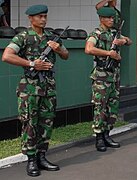
Fencing is a combat sport that features sword fighting. The three disciplines of modern fencing are the foil, the épée, and the sabre ; each discipline uses a different kind of blade, which shares the same name, and employs its own rules. Most competitive fencers specialise in one discipline. The modern sport gained prominence near the end of the 19th century and is based on the traditional skill set of swordsmanship. The Italian school altered the historical European martial art of classical fencing, and the French school later refined that system. Scoring points in a fencing competition is done by making contact with an opponent.
A sword is an edged, bladed weapon intended for manual cutting or thrusting. Its blade, longer than a knife or dagger, is attached to a hilt and can be straight or curved. A thrusting sword tends to have a straighter blade with a pointed tip. A slashing sword is more likely to be curved and to have a sharpened cutting edge on one or both sides of the blade. Many swords are designed for both thrusting and slashing. The precise definition of a sword varies by historical epoch and geographic region.

A salute is usually a formal hand gesture or other action used to display respect in military situations. Salutes are primarily associated with the military and law enforcement, but many civilian organizations, such as Girl Guides, Boy Scouts and the Salvation Army use formal salutes. Ordinary civilians also salute informally to greet or acknowledge the presence of another person, such as a tip of the hat or a hand wave to a friend or neighbor.

In military organizations, a colour guard is a detachment of soldiers assigned to the protection of regimental colours and the national flag. This duty is highly prestigious, and the military colour is generally carried by a young officer (ensign), while experienced non-commissioned officers are assigned to the protection of the national flag. These non-commissioned officers, accompanied in several countries by warrant officers, can be ceremonially armed with either sabres or rifles to protect the colour. Colour guards are generally dismounted, but there are also mounted colour guard formations as well.

A bayonet is a knife, dagger, sword, or spike-shaped weapon designed to fit on the end of the muzzle of a rifle, carbine, musket or similar firearm, allowing it to be used as a spear-like weapon. From the early 17th to the early 20th century, it was a melee weapon used by infantry for offensive and/or defensive tactics. Today, it is considered an ancillary weapon or weapon of last resort, although it is still used for ceremonial purposes.

The IMI Galil is a family of Israeli-made automatic rifles chambered for the 5.56×45mm NATO and 7.62×51mm NATO cartridges. Originally designed by Yisrael Galili and Yakov Lior in the late 1960s, the Galil was first produced by the state-owned Israel Military Industries and is now exported by the privatized Israel Weapon Industries.
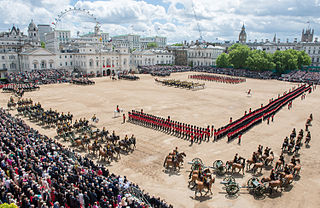
Trooping the Colour is a ceremonial event performed every year on Horse Guards Parade in London, United Kingdom, by regiments of Household Division, to celebrate the official birthday of the British sovereign. It is also known as the Sovereign's Birthday Parade. Similar events are held in other countries of the Commonwealth. In the UK, it is, with the State Opening of Parliament, one of the biggest events of the ceremonial calendar, and watched by millions on TV and on the streets of London.

Drill commands are generally used with a group that is marching, most often in military foot drills or in a marching band. Drill commands are usually heard in major events involving service personnel, reservists and veterans of a country's armed forces, and by extension, public security services and youth uniformed organizations.

The Stoner 63 is a 5.56×45mm NATO modular weapon system. Using a variety of modular components, it can be configured as an assault rifle, carbine, top-fed light machine gun, belt-fed squad automatic weapon, or as a vehicle mounted weapon. Also known as the M63, XM22, XM23, XM207 or the Mk 23 Mod 0 machine gun, it was designed by Eugene Stoner in the early 1960s. Cadillac Gage was the primary manufacturer of the Stoner 63 during its history. The Stoner 63 saw very limited combat use by United States forces during the Vietnam War. A few were also sold to law enforcement agencies.

The following outline is provided as an overview of and topical guide to fencing:
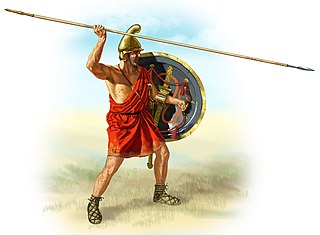
The army of the Kingdom of Macedon was among the greatest military forces of the ancient world. It was created and made formidable by King Philip II of Macedon; previously the army of Macedon had been of little account in the politics of the Greek world, and Macedonia had been regarded as a second-rate power.

The position of at attention, or standing at attention, is a military posture which involves the following general postures:

The Pattern 1908 cavalry trooper's sword was the last service sword issued to the cavalry of the British Army. It has been called the most effective cavalry sword ever designed, although its introduction occurred as swords finally became obsolete as military weapons. In use, it, like other thrust-based cavalry swords, is best described as a one-handed lance, due to its complete lack of utility for anything but the charge. In fact, the closely related US Model 1913 Cavalry Saber was issued with only a saddle scabbard, as it was not considered to be of much use to a dismounted cavalryman. Colonial troops, who could expect to engage in melee combat with opposing cavalry frequently carried cut and thrust swords either instead of, or in addition to, the P1908/1912.

The Pattern 1796 heavy cavalry sword was the sword used by the British heavy cavalry, and King's German Legion Dragoons, through most of the period of the Revolutionary and Napoleonic Wars. It played an especially notable role, in the hands of British cavalrymen, at the battles of Salamanca and Waterloo. The pattern was adopted by Sweden and was used by some Portuguese cavalry.
This is a glossary of terms used in fencing.
Independence Day, also known as the Fifth of July is the national independence holiday of Venezuela, marked every year on July 5 which celebrates the anniversary since the enactment of the 1811 Venezuelan Declaration of Independence, making the country the first Spanish colony in South America to declare independence. In recent years, it is also marked as National Armed Forces Day to honor the faithful service of all the serving men and women and veterans of the National Bolivarian Armed Forces of Venezuela.

USMC Sword Manual Procedures are commonly used in the Marine Corps. Marines considered Non-commissioned Officers (NCO) as well as Staff Non-Commissioned Officers (SNCO) may find themselves having to perform "Sword Manual", which is a stationary drill.
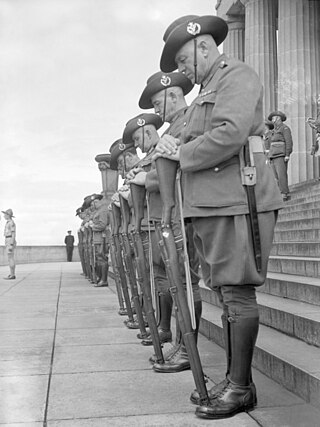
Reverse arms and the related rest on arms reversed are military drill commands used as a mark of respect at funerals and on occasions of mourning, especially in the armed forces of Commonwealth nations. When marching in reverse arms the soldier's weapon is held pointing behind them and grasped behind their back. When resting on reversed arms the weapon points towards the ground and the eyes are lowered.

The Culture of the Russian Armed Forces is widely varied, but unique amongst the branches of the armed forces, and shared with the other uniformed organizations within Russia. Military culture is the most important component of military life. The major cultural events held by the Russian military are primarily aimed at strengthening esprit de corps as well as advancing the historical traditions of the Armed Forces of Russia. The Ministry of Defence of Russia regularly holds cultural events at various levels. The central cultural institutions of the Ministry of Defense of the Russian Federation are actively working in all military districts.
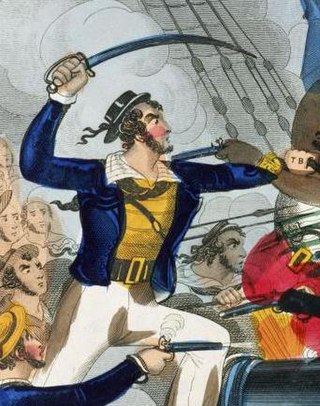
Ratings of the Royal Navy have used cutlasses, short, wide bladed swords, since the early 18th century. These were originally of non-uniform design but the 1804 Pattern, the first Navy-issue standard cutlass, was introduced at the start of the 19th century. This was a bluntish weapon that was perhaps intended for cutting away canvas and ropes rather than as a thrusting combat weapon. The 1845 Pattern cutlass introduced a bowl-style hand guard which provided greater protection, with a longer and more curved blade. Its sharper point made it more useful for thrusting attacks, which were now emphasised in the drill manual. The 1845 Pattern was modified several times including shortening and straightening the blades, which weakened them. The 1889 Pattern had a straight, spear-pointed blade with a hilt that curved outwards to catch and redirect an opponent's sword point. The 1900 Pattern, the last navy-issue cutlass, was similar to its predecessor with the introduction of a fuller and a hilt insert that cushioned the user's little finger. The cutlass was withdrawn from service in 1936 but remains in use for ceremonial purposes. It is thought that it was last used in combat in 1900 during the Boxer Rebellion.





